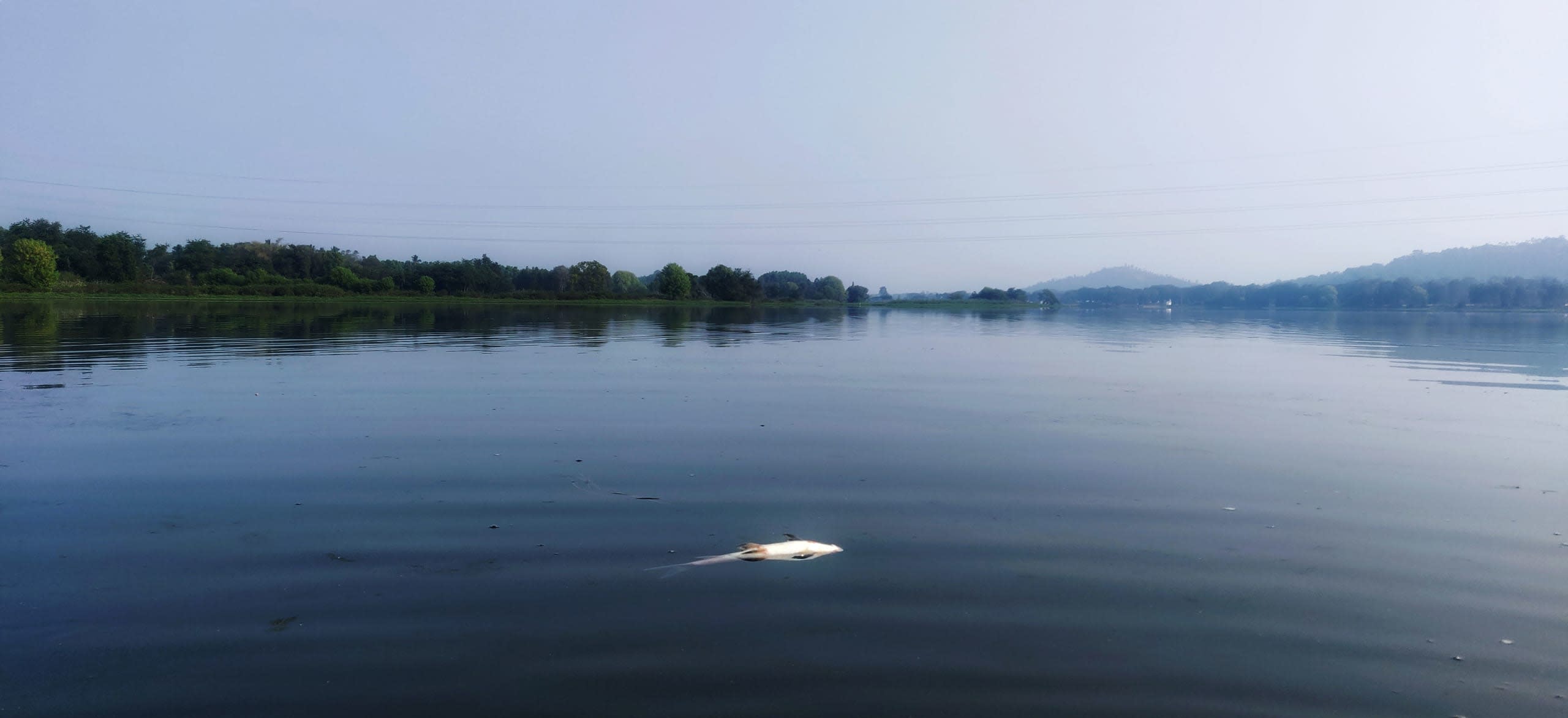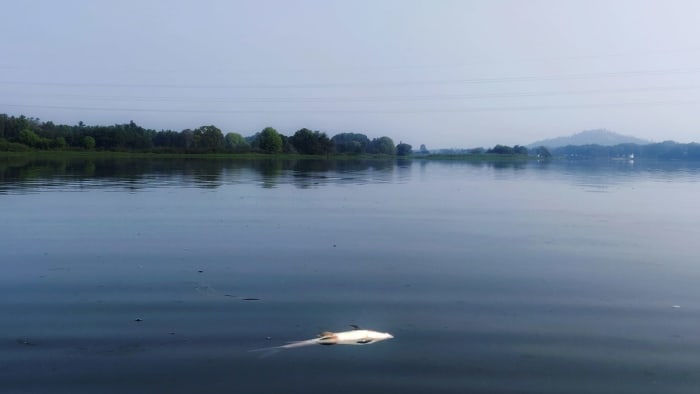 Listen to this article
•
15:34 min
Listen to this article
•
15:34 min
The Cauvery, one of India’s sacred rivers and a lifeline for many, is dying. Like many other rivers in India and around the world, its water quality has degraded and become polluted, and tracts of it are drying up and suffering the consequences of drought. There are numerous reasons for this: sewage pollution, mismanagement of alien fish, agricultural discharge, dams, sand mining, and even climate change.
Fish numbers declining
The pollution in the river impacts fish populations adversely. A 2017 report of the Environmental Management & Policy Research Institute on the ecology and water quality of the Cauvery River notes that the once abundant diversity of fish has now declined.
“Earlier, there were many species of carp, but now, due to river pollution, they are dying,” says Bhavani CN, Assistant Director of Fisheries at T. Narasipura. “Carp are very sensitive and are affected when their natural habitat is disturbed by human activity or water stagnation.” The pollution in the Cauvery is from effluents and sewage released directly into the river from residences and temples in the towns of T Narasipura and Srirangapatna.
Because carp are bottom dwellers, sand mining and dredging impact their habitat too. Additionally, “they lay eggs during the monsoon, but with changes in rain patterns, their lifecycle has been disturbed, leading to a decline in numbers.”
Cover photo: Illegal dynamite fishing kills large quantities of fish, impacting the livelihoods of other fishers and the otters that depend on adequate fish stocks to survive. Photo: Sugandhi Gadadhar and Rana Belur (part of their work supported by the National Geographic Society)
Water quality in the Cauvery
Water quality in many stretches of the river has deteriorated due to lack of proper sanitation, discharge of pesticides and agrochemicals, sewage disposal into the river, and other human activities. “Ten years back, the coffee curing industry directly discharged effluents into the Cauvery River. Now, mostly household sewage is contaminating the waters, especially those of Lakshmantheeratha, the main tributary to the Cauvery, which receives direct household sewage from Hunsur,” says S Srikanta Swamy, Professor of Environmental Science at the University of Mysore, who has been studying Cauvery water quality.
In 2016, Professor Swamy’s team analysed the river sediment for heavy metals and found that the concentration exceeded the upper limit of permissible standards. Heavy metal toxicity in aquatic ecosystems can cause oxidative stress in fish – an imbalance of toxic products formed in the body from oxygen — which may result in metabolic disorders or chronic diseases. Swamy’s team also interviewed fishers to study the socioeconomic impacts of pollution on fishing communities. The local fishing communities said that they are impacted by water level fluctuations in the river and toxic chemicals affecting water quality.
Industrial effluents and sewage continue to plague the Cauvery River today, affecting the health of villagers who depend on it for water for cleaning and drinking. The pollution also causes the death of livestock and fish. The direct release of sewage into the river is not unique to the Cauvery. According to report by the Central Pollution Control Board, of the 72,000 million litres a day of sewage generated in India, less than 50 per cent is treated in sewage treatment plants. The rest is released directly into rivers and seas.
Under a nationwide River Water Quality Monitoring Project, the Cauvery’s water quality was monitored by a team from Sri Jayachamarajendra College of Engineering, Mysore, under KS Lokesh, Professor of Environmental Engineering at the college. The study ran for 12 years from 2000 to 2011 and water quality was monitored every month under five water parameters.
“The quality of water was severely damaged due to indiscriminate release of sewage and domestic wastewater into the river, from the Merkera region to Srirangapatna,” says K S Lokesh. “The bacteriological load was high. Heavy metal pollution was 600 to 800 times permissible values, due to the presence of pesticides and fertilisers from agriculture fields.” Added to this is the pollution from industries along the tributaries.
Algae blooms kill fish
He added that the quality of the water in summer was especially poor. At certain points along the river, in towns like Hunsur, the high organic load from sewage has caused algae blooms to proliferate. Algae blooms consume oxygen, reducing the amount of oxygen available to fish, ultimately causing them to die.

Invasive species thrive
A high organic load and sewage pollution has also aided the proliferation of two invasive fish species, tilapia, and African catfish. “Tilapia are hardy fish,” says Bhavani, “they proliferate very fast. Unlike native fish, they grow even in sewage contaminated waters. Catfish can also grow in polluted waters, as the species is both air breathing and gill breathing.” India’s National Biodiversity Authority lists the tilapia and African catfish as major threats to the country’s freshwater biodiversity. These alien species initially spread to rivers and fresh waters from farmed aquaculture, and have now destroyed several native fish stocks, including carp. While tilapia is of high economic value to fishers as it fetches a good price in the market, it destroys native ecosystems.
Global warming
Global warming may also play a role in the decline of native fish. With rising temperatures and changes in rainfall patterns, native species will find it harder to survive. Invasive species have a better chance of survival in these changing weather conditions, notes a 2022 study by Atul K Singh and Sharad C Srivastava of the National Bureau of Fish Genetic Resources.
According to a new study published in June 2022 in Nature Scientific Reports, the temperature of the waters of Ganga, Narmada, Cauvery, Sabarmati, Tungabhadra, Musi, and Godavari could increase up to 35 degrees C by 2070-2100. At these temperatures, fish and other aquatic creatures that need dissolved oxygen to breathe will not be able to survive for long, as oxygen does not dissolve easily in warm waters.
As anthropogenic (human-induced) activities increase on riverbanks, and development continues unchecked, our once sacred rivers are turning into cesspools of pollution, untreated sewage, and industrial effluents. Additionally, habitat alteration and fragmentation due to sand mining, dams, and water diversion have affected fish diversity and the river landscape. Exacerbating this mix is global warming, which puts additional stress on native fishes. With all the factors working against it, the odds are stacked heavily against the Cauvery River, its fish, fishers, and vulnerable otters.
Photo source (sewage near Cauvery)
This story is the second of a three-part series on the Cauvery river ecosystem. In the third instalment, read how the river is also a habitat of smooth-coated otters. As they adapt to changes, they come into increased conflict with humans. You can read the first part of the series here.
The reporting for this series was supported by the International Women's Media Foundation's Howard G. Buffet Fund for Women Journalists.














